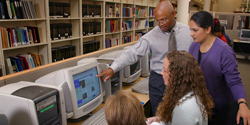
Prior Knowledge | Graphic Organizers | Co-operative Learning | Feedback | Recognition | Questioning | Modelling

Managing ICT
Teaching and Learning Strategies
ICT Resources
There are several online resources with strategies for managing ICT in the classroom. |
ICT can play a big part in project-based learning. The use of ICT enhances the learning experience and allows learners make connections to the outside world. It gives learners a place to find resources and to create work products. Efficient management of available ICT during projects takes planning and organization.
The One-Computer Classroom
One of the biggest challenges many teachers face is the lack of computers. Even with only one computer in the classroom, there are many ways to use ICT effectively to improve learner learning.
- Pair learners up and set up a daily computer use schedule.
- Try to find time to have open blocks of time for individual learner use.
- Use a timer to keep learners to their time limits.
- Make sure computer time is used for creating products and doing research. All other pre-planning work should be done ahead of time (storyboards are a good way to do this).
- Use teacher-created templates for learners to fill in to save time.
- Display posters using computer terms and commands.
- Make sure computer etiquette and guidelines have been modelled.
On the designated days, particular groups of learners have access to the computer. They can work independently or in pairs depending on the work that needs to be completed. If a computer is open and not being used by a member of the assigned group, anyone can use it until it is needed.
Learning Stations
Learning stations provide teachers and learners a structured way to rotate through a small number of computers during class time. With access to three or four computers, learners get more time and extended opportunities to work with ICT to create projects. Stations should be connected to one another in a way that makes sense for the learners to rotate through in a timely fashion. These stations can be set up so the content they are learning and work they are producing relates to each other. For example:
- Station One: Storyboard planning
- Station Two: Peer reviewing and feedback
- Station Three: Revising and drafting
- Station Four: Computer use to create work products
- Station Five: Computer use: researching, working with experts on the computer, publishing
The amount of time devoted to learning stations depends on
how much time is available and the amount of work that will be
expected of the learners. The important piece in using learning
stations effectively is making sure learners are aware of what to do
at each station through teacher modeling and monitoring. They should
be held accountable for their work with checklists and/or teacher
conferencing and have a place to store their works in progress for the
next day.
Computer Labs
Computer labs are another way to get learners using ICT.
With the use of computer labs, learners are given chunks of time
during the week to use computers. With these labs, learners must come
prepared with the work they need to complete using the computer.
Because time is always limited, learners need to be able to work
independently and efficiently. Depending on how many computers there
are, learners can work on the computers independently or in pairs.
Non-computer learning stations can take place in the classroom
beforehand, and the computer station can be saved for the visit to the
lab.
